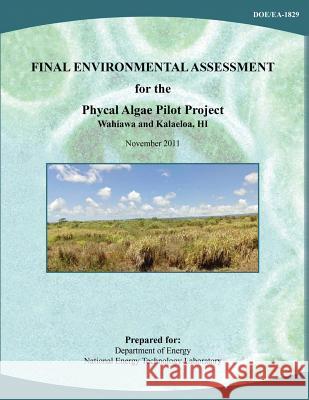Final Environmental Assessment for the Phycal Algae Pilot Project, Wahiawa and Kalaeloa, HI (DOE/EA-1829) » książka
Final Environmental Assessment for the Phycal Algae Pilot Project, Wahiawa and Kalaeloa, HI (DOE/EA-1829)
ISBN-13: 9781482553468 / Angielski / Miękka / 2013 / 126 str.
Final Environmental Assessment for the Phycal Algae Pilot Project, Wahiawa and Kalaeloa, HI (DOE/EA-1829)
ISBN-13: 9781482553468 / Angielski / Miękka / 2013 / 126 str.
(netto: 80,88 VAT: 5%)
Najniższa cena z 30 dni: 84,23 zł
ok. 16-18 dni roboczych
Bez gwarancji dostawy przed świętami
Darmowa dostawa!
DOE prepared this Environmental Assessment (EA) to assess the potential for impacts to the human and natural environment of its Proposed Action -- providing financial assistance to Phycal under a cooperative agreement. DOE's objective is to support the development of innovative concepts for beneficial CO2 use, which include, but are not limited to, CO2 mineralization to carbonates directly through conversion of CO2 in flue gas; use of CO2 from power plants or industrial applications to grow algae or biomass. Under the terms of the cooperative agreement, DOE would provide approximately 80 percent of the funding for the development of a pilot algae farm and processing facility in Wahiawa and Kalaeloa, Hawaii, to demonstrate the beneficial use of CO2 for the growing of algae and production of algal oil (referred to as the proposed project within this EA). The proposed project would develop algae technology that demonstrates the future potential of algae oil for biofuels at a level that results in technical, economic, and environmental advantages. This advanced technology would not only help to enhance U.S. energy supplies through the responsible development of domestic renewable energy but would also help to reduce CO2 emissions to the atmosphere. The proposed project would include developing an algae farm and processing facility, which would include constructing shallow ponds, greenhouses, lab/offices, a process building, and an outdoor area with various processing equipment facilities. The proposed project would be split into two phases or Modules. Module 1 would provide a baseline assessment of core processes and initial optimization. Module 2 would include the scaling and integration of supporting processes. The overall objective of proposed project would be to confirm the process economics prior to commencing to a commercial scale, development of which is not funded under this award. The proposed project would create approximately 20 jobs in Module 1, and another 20 jobs in Module 2, for the total duration of the approximately three-year pilot. The environmental analysis identified that the most notable, although minor, changes to result from the proposed project would occur in the following areas: utilities and energy use, air quality and greenhouse gas, noise, geology and soils, vegetation and wildlife, solid and hazardous wastes, transportation and traffic, and human health and safety. No significant environmental effects were identified in analyzing the potential consequences of these changes.
Zawartość książki może nie spełniać oczekiwań – reklamacje nie obejmują treści, która mogła nie być redakcyjnie ani merytorycznie opracowana.











